Analysis of Wrongful Convictions and Ethical Concerns in Law
VerifiedAdded on 2023/01/13
|21
|6570
|36
Essay
AI Summary
This essay provides a comprehensive analysis of wrongful convictions within the criminal justice system, focusing on the ethical problems that contribute to these miscarriages of justice. The paper examines the roles of law enforcement, the prosecution, and trial misconduct, highlighting issues such as poor investigations, suggestive practices, racial bias, and the withholding of evidence. It delves into the exoneration process, particularly the impact of DNA analysis on overturning wrongful convictions and the consequences faced by exonerated individuals. Furthermore, the essay explores the application of criminology theories, including deontology, virtues of ethics, and peacemaking, to identify potential strategies for reducing the incidence of wrongful convictions. The essay draws upon a range of sources, including legal cases, reports, and academic studies, to support its arguments and provide a nuanced understanding of the complexities surrounding wrongful convictions.
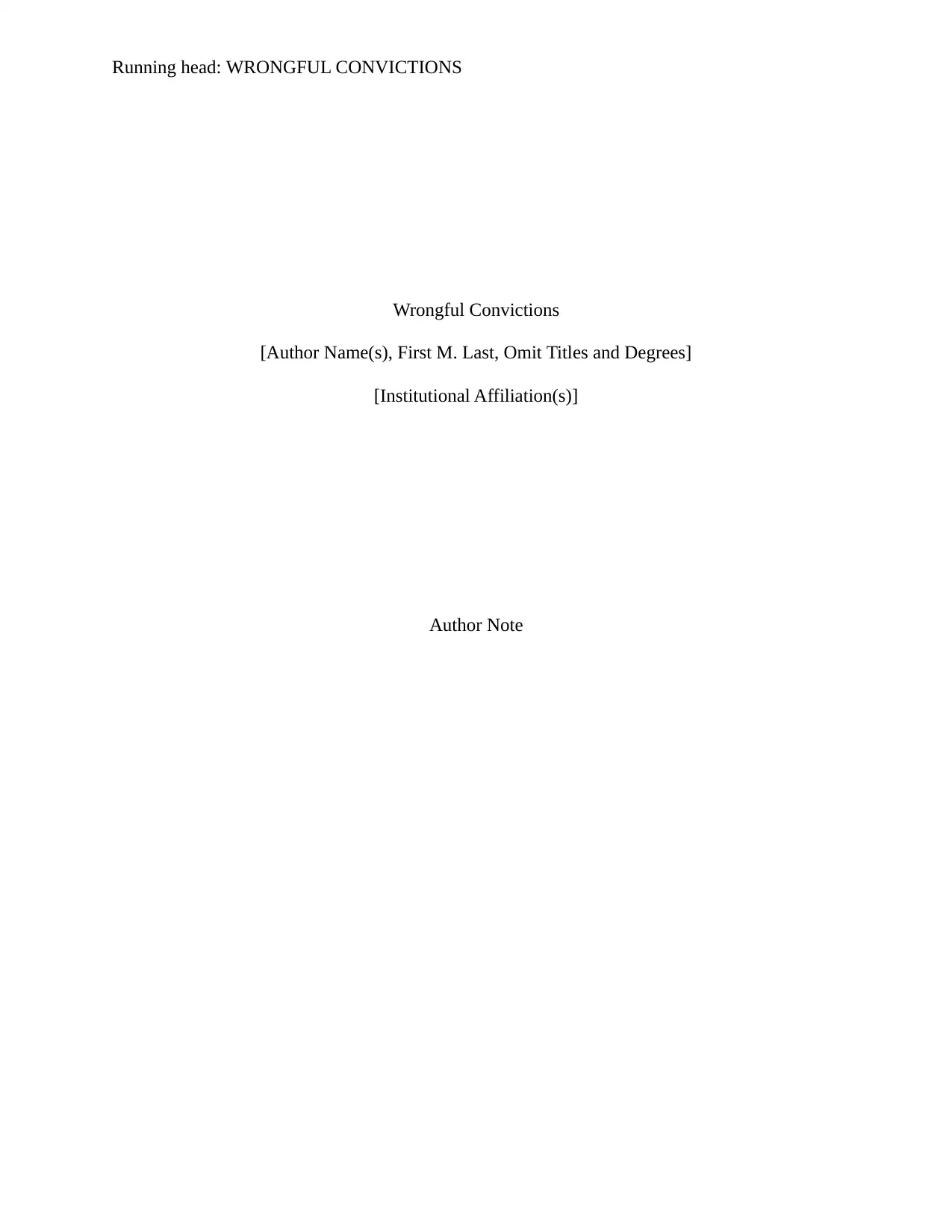
Running head: WRONGFUL CONVICTIONS
Wrongful Convictions
[Author Name(s), First M. Last, Omit Titles and Degrees]
[Institutional Affiliation(s)]
Author Note
Wrongful Convictions
[Author Name(s), First M. Last, Omit Titles and Degrees]
[Institutional Affiliation(s)]
Author Note
Paraphrase This Document
Need a fresh take? Get an instant paraphrase of this document with our AI Paraphraser
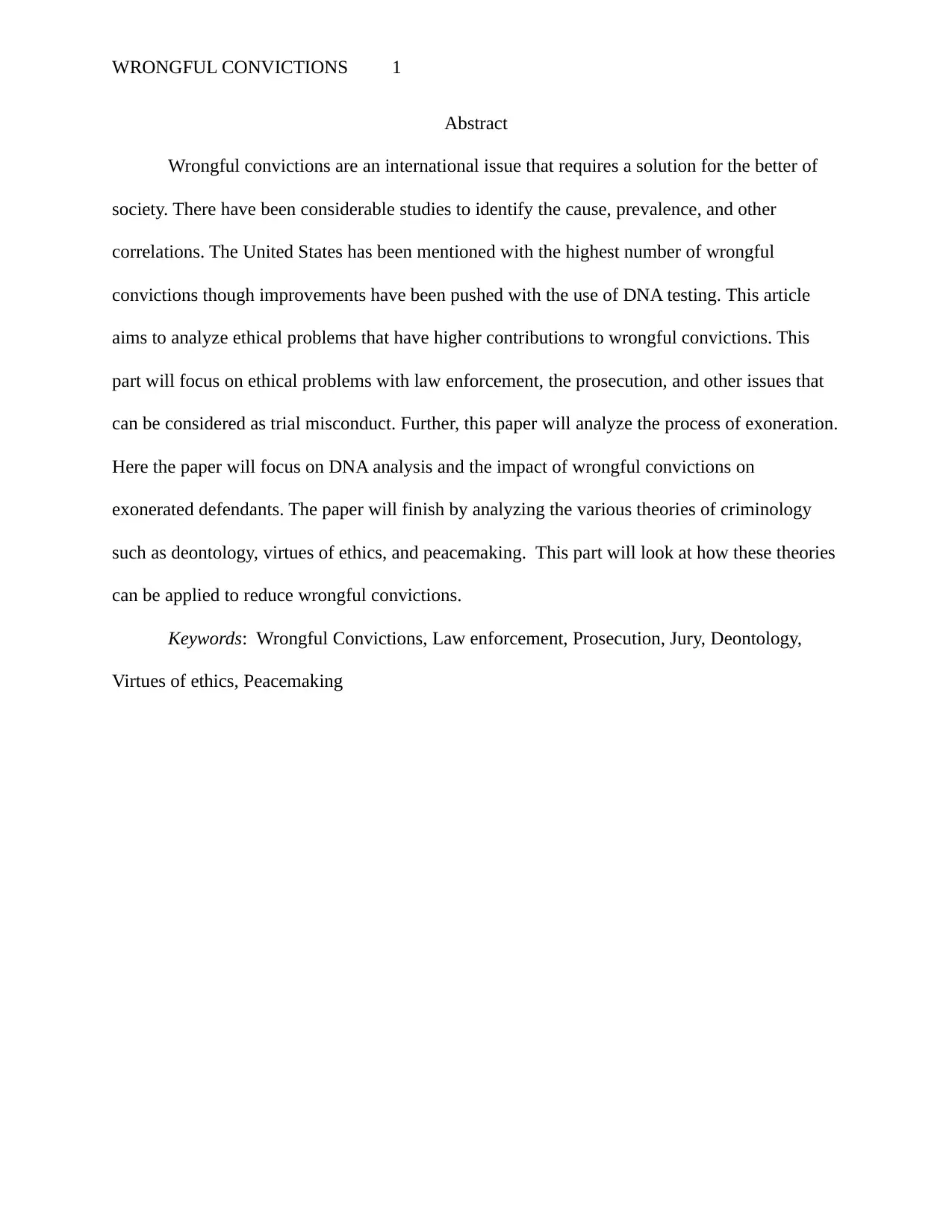
WRONGFUL CONVICTIONS 1
Abstract
Wrongful convictions are an international issue that requires a solution for the better of
society. There have been considerable studies to identify the cause, prevalence, and other
correlations. The United States has been mentioned with the highest number of wrongful
convictions though improvements have been pushed with the use of DNA testing. This article
aims to analyze ethical problems that have higher contributions to wrongful convictions. This
part will focus on ethical problems with law enforcement, the prosecution, and other issues that
can be considered as trial misconduct. Further, this paper will analyze the process of exoneration.
Here the paper will focus on DNA analysis and the impact of wrongful convictions on
exonerated defendants. The paper will finish by analyzing the various theories of criminology
such as deontology, virtues of ethics, and peacemaking. This part will look at how these theories
can be applied to reduce wrongful convictions.
Keywords: Wrongful Convictions, Law enforcement, Prosecution, Jury, Deontology,
Virtues of ethics, Peacemaking
Abstract
Wrongful convictions are an international issue that requires a solution for the better of
society. There have been considerable studies to identify the cause, prevalence, and other
correlations. The United States has been mentioned with the highest number of wrongful
convictions though improvements have been pushed with the use of DNA testing. This article
aims to analyze ethical problems that have higher contributions to wrongful convictions. This
part will focus on ethical problems with law enforcement, the prosecution, and other issues that
can be considered as trial misconduct. Further, this paper will analyze the process of exoneration.
Here the paper will focus on DNA analysis and the impact of wrongful convictions on
exonerated defendants. The paper will finish by analyzing the various theories of criminology
such as deontology, virtues of ethics, and peacemaking. This part will look at how these theories
can be applied to reduce wrongful convictions.
Keywords: Wrongful Convictions, Law enforcement, Prosecution, Jury, Deontology,
Virtues of ethics, Peacemaking
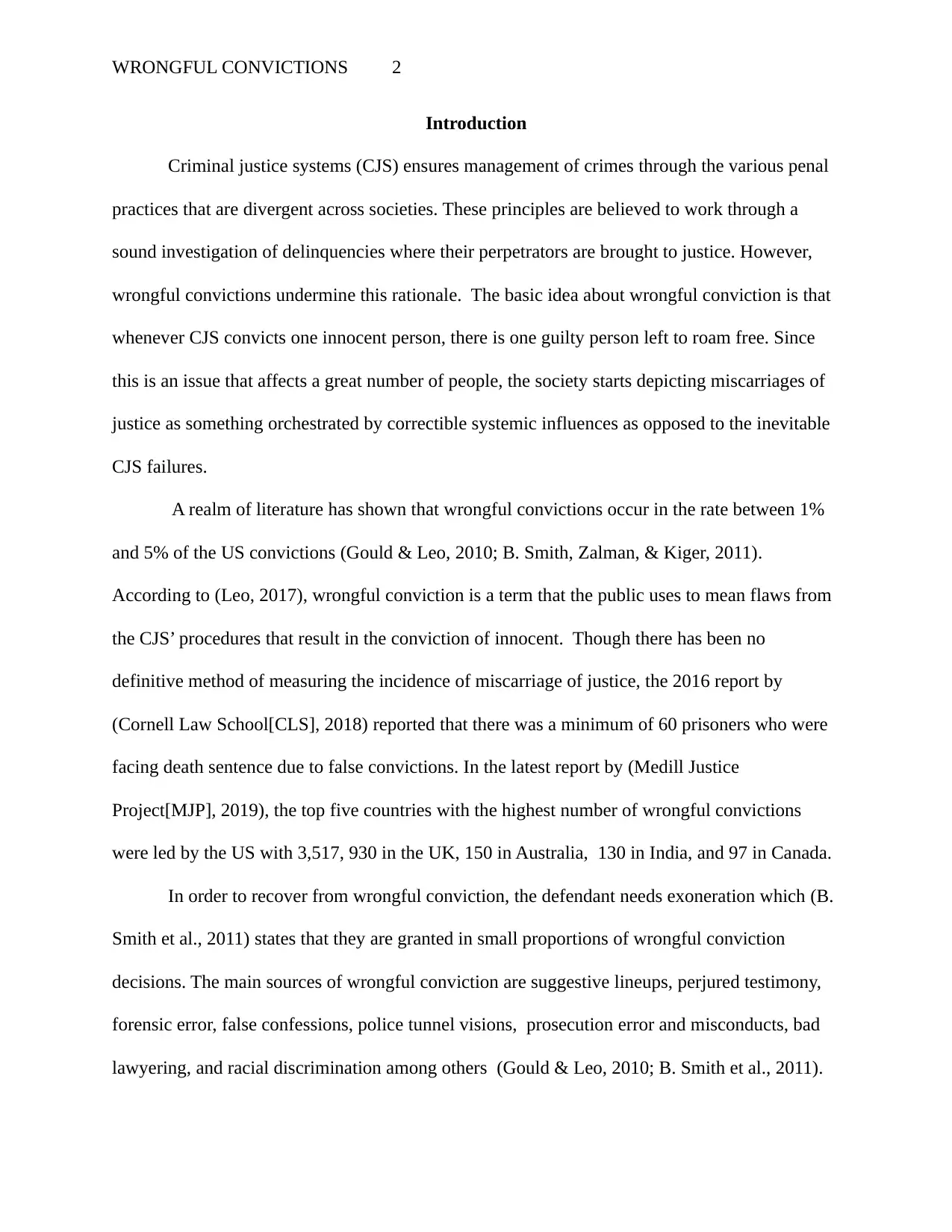
WRONGFUL CONVICTIONS 2
Introduction
Criminal justice systems (CJS) ensures management of crimes through the various penal
practices that are divergent across societies. These principles are believed to work through a
sound investigation of delinquencies where their perpetrators are brought to justice. However,
wrongful convictions undermine this rationale. The basic idea about wrongful conviction is that
whenever CJS convicts one innocent person, there is one guilty person left to roam free. Since
this is an issue that affects a great number of people, the society starts depicting miscarriages of
justice as something orchestrated by correctible systemic influences as opposed to the inevitable
CJS failures.
A realm of literature has shown that wrongful convictions occur in the rate between 1%
and 5% of the US convictions (Gould & Leo, 2010; B. Smith, Zalman, & Kiger, 2011).
According to (Leo, 2017), wrongful conviction is a term that the public uses to mean flaws from
the CJS’ procedures that result in the conviction of innocent. Though there has been no
definitive method of measuring the incidence of miscarriage of justice, the 2016 report by
(Cornell Law School[CLS], 2018) reported that there was a minimum of 60 prisoners who were
facing death sentence due to false convictions. In the latest report by (Medill Justice
Project[MJP], 2019), the top five countries with the highest number of wrongful convictions
were led by the US with 3,517, 930 in the UK, 150 in Australia, 130 in India, and 97 in Canada.
In order to recover from wrongful conviction, the defendant needs exoneration which (B.
Smith et al., 2011) states that they are granted in small proportions of wrongful conviction
decisions. The main sources of wrongful conviction are suggestive lineups, perjured testimony,
forensic error, false confessions, police tunnel visions, prosecution error and misconducts, bad
lawyering, and racial discrimination among others (Gould & Leo, 2010; B. Smith et al., 2011).
Introduction
Criminal justice systems (CJS) ensures management of crimes through the various penal
practices that are divergent across societies. These principles are believed to work through a
sound investigation of delinquencies where their perpetrators are brought to justice. However,
wrongful convictions undermine this rationale. The basic idea about wrongful conviction is that
whenever CJS convicts one innocent person, there is one guilty person left to roam free. Since
this is an issue that affects a great number of people, the society starts depicting miscarriages of
justice as something orchestrated by correctible systemic influences as opposed to the inevitable
CJS failures.
A realm of literature has shown that wrongful convictions occur in the rate between 1%
and 5% of the US convictions (Gould & Leo, 2010; B. Smith, Zalman, & Kiger, 2011).
According to (Leo, 2017), wrongful conviction is a term that the public uses to mean flaws from
the CJS’ procedures that result in the conviction of innocent. Though there has been no
definitive method of measuring the incidence of miscarriage of justice, the 2016 report by
(Cornell Law School[CLS], 2018) reported that there was a minimum of 60 prisoners who were
facing death sentence due to false convictions. In the latest report by (Medill Justice
Project[MJP], 2019), the top five countries with the highest number of wrongful convictions
were led by the US with 3,517, 930 in the UK, 150 in Australia, 130 in India, and 97 in Canada.
In order to recover from wrongful conviction, the defendant needs exoneration which (B.
Smith et al., 2011) states that they are granted in small proportions of wrongful conviction
decisions. The main sources of wrongful conviction are suggestive lineups, perjured testimony,
forensic error, false confessions, police tunnel visions, prosecution error and misconducts, bad
lawyering, and racial discrimination among others (Gould & Leo, 2010; B. Smith et al., 2011).
⊘ This is a preview!⊘
Do you want full access?
Subscribe today to unlock all pages.

Trusted by 1+ million students worldwide
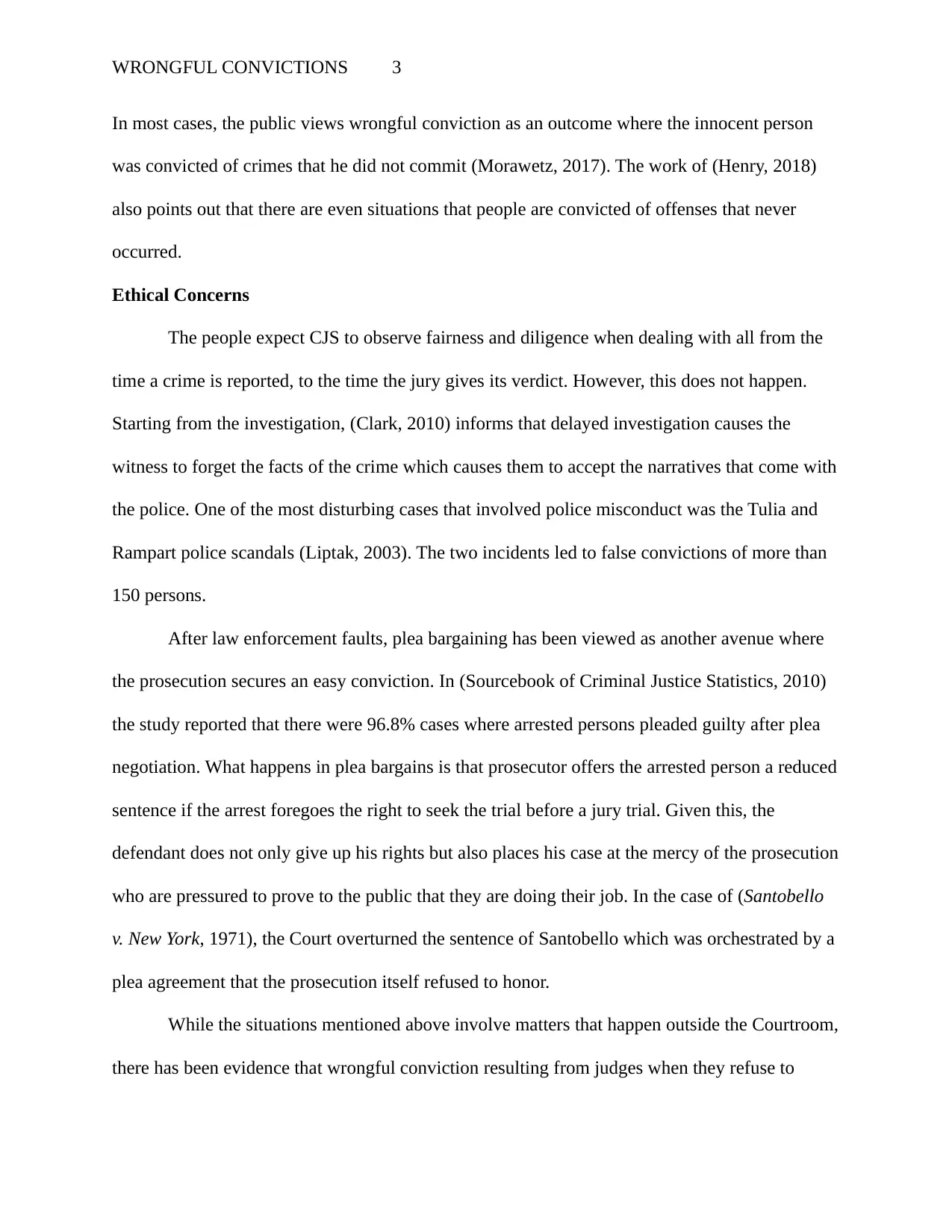
WRONGFUL CONVICTIONS 3
In most cases, the public views wrongful conviction as an outcome where the innocent person
was convicted of crimes that he did not commit (Morawetz, 2017). The work of (Henry, 2018)
also points out that there are even situations that people are convicted of offenses that never
occurred.
Ethical Concerns
The people expect CJS to observe fairness and diligence when dealing with all from the
time a crime is reported, to the time the jury gives its verdict. However, this does not happen.
Starting from the investigation, (Clark, 2010) informs that delayed investigation causes the
witness to forget the facts of the crime which causes them to accept the narratives that come with
the police. One of the most disturbing cases that involved police misconduct was the Tulia and
Rampart police scandals (Liptak, 2003). The two incidents led to false convictions of more than
150 persons.
After law enforcement faults, plea bargaining has been viewed as another avenue where
the prosecution secures an easy conviction. In (Sourcebook of Criminal Justice Statistics, 2010)
the study reported that there were 96.8% cases where arrested persons pleaded guilty after plea
negotiation. What happens in plea bargains is that prosecutor offers the arrested person a reduced
sentence if the arrest foregoes the right to seek the trial before a jury trial. Given this, the
defendant does not only give up his rights but also places his case at the mercy of the prosecution
who are pressured to prove to the public that they are doing their job. In the case of (Santobello
v. New York, 1971), the Court overturned the sentence of Santobello which was orchestrated by a
plea agreement that the prosecution itself refused to honor.
While the situations mentioned above involve matters that happen outside the Courtroom,
there has been evidence that wrongful conviction resulting from judges when they refuse to
In most cases, the public views wrongful conviction as an outcome where the innocent person
was convicted of crimes that he did not commit (Morawetz, 2017). The work of (Henry, 2018)
also points out that there are even situations that people are convicted of offenses that never
occurred.
Ethical Concerns
The people expect CJS to observe fairness and diligence when dealing with all from the
time a crime is reported, to the time the jury gives its verdict. However, this does not happen.
Starting from the investigation, (Clark, 2010) informs that delayed investigation causes the
witness to forget the facts of the crime which causes them to accept the narratives that come with
the police. One of the most disturbing cases that involved police misconduct was the Tulia and
Rampart police scandals (Liptak, 2003). The two incidents led to false convictions of more than
150 persons.
After law enforcement faults, plea bargaining has been viewed as another avenue where
the prosecution secures an easy conviction. In (Sourcebook of Criminal Justice Statistics, 2010)
the study reported that there were 96.8% cases where arrested persons pleaded guilty after plea
negotiation. What happens in plea bargains is that prosecutor offers the arrested person a reduced
sentence if the arrest foregoes the right to seek the trial before a jury trial. Given this, the
defendant does not only give up his rights but also places his case at the mercy of the prosecution
who are pressured to prove to the public that they are doing their job. In the case of (Santobello
v. New York, 1971), the Court overturned the sentence of Santobello which was orchestrated by a
plea agreement that the prosecution itself refused to honor.
While the situations mentioned above involve matters that happen outside the Courtroom,
there has been evidence that wrongful conviction resulting from judges when they refuse to
Paraphrase This Document
Need a fresh take? Get an instant paraphrase of this document with our AI Paraphraser
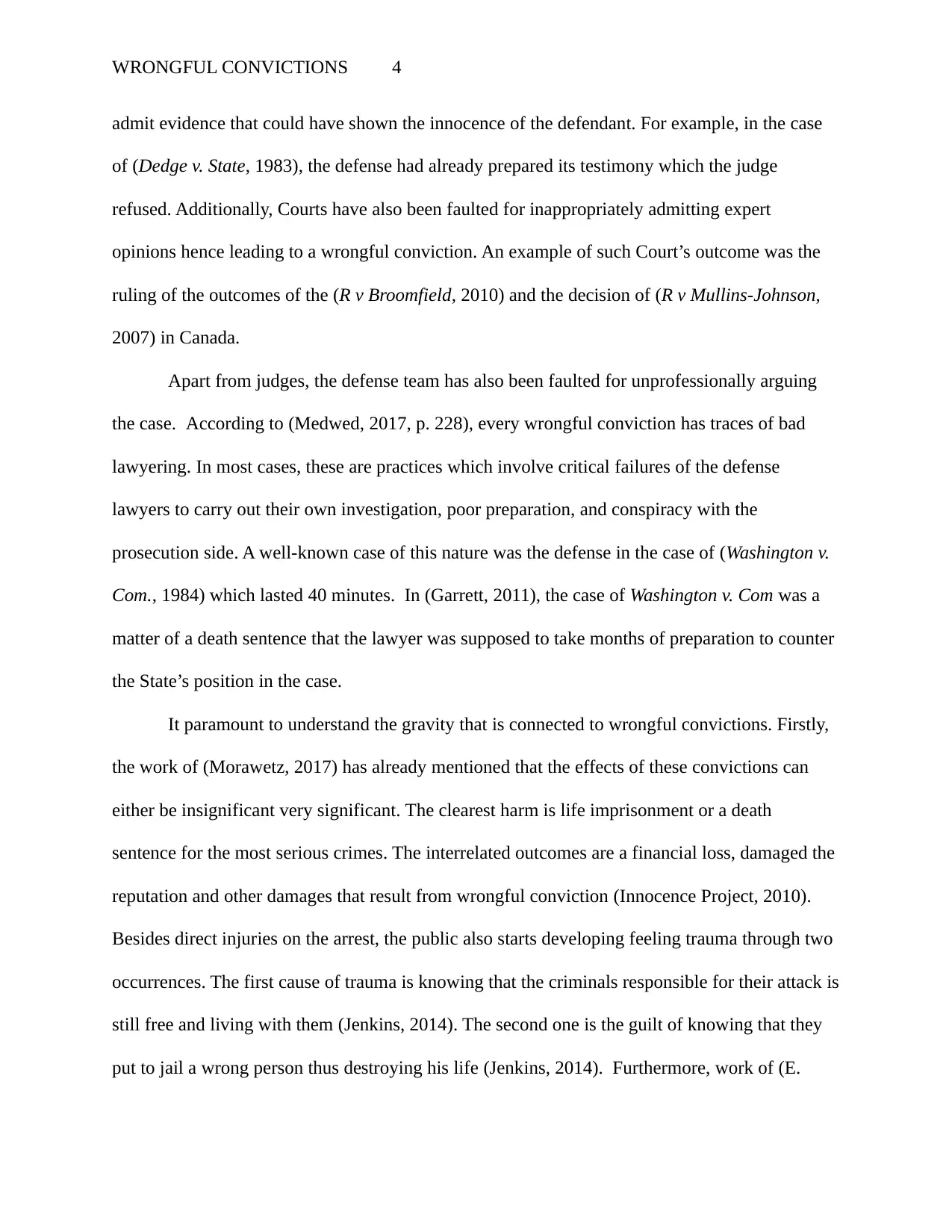
WRONGFUL CONVICTIONS 4
admit evidence that could have shown the innocence of the defendant. For example, in the case
of (Dedge v. State, 1983), the defense had already prepared its testimony which the judge
refused. Additionally, Courts have also been faulted for inappropriately admitting expert
opinions hence leading to a wrongful conviction. An example of such Court’s outcome was the
ruling of the outcomes of the (R v Broomfield, 2010) and the decision of (R v Mullins-Johnson,
2007) in Canada.
Apart from judges, the defense team has also been faulted for unprofessionally arguing
the case. According to (Medwed, 2017, p. 228), every wrongful conviction has traces of bad
lawyering. In most cases, these are practices which involve critical failures of the defense
lawyers to carry out their own investigation, poor preparation, and conspiracy with the
prosecution side. A well-known case of this nature was the defense in the case of (Washington v.
Com., 1984) which lasted 40 minutes. In (Garrett, 2011), the case of Washington v. Com was a
matter of a death sentence that the lawyer was supposed to take months of preparation to counter
the State’s position in the case.
It paramount to understand the gravity that is connected to wrongful convictions. Firstly,
the work of (Morawetz, 2017) has already mentioned that the effects of these convictions can
either be insignificant very significant. The clearest harm is life imprisonment or a death
sentence for the most serious crimes. The interrelated outcomes are a financial loss, damaged the
reputation and other damages that result from wrongful conviction (Innocence Project, 2010).
Besides direct injuries on the arrest, the public also starts developing feeling trauma through two
occurrences. The first cause of trauma is knowing that the criminals responsible for their attack is
still free and living with them (Jenkins, 2014). The second one is the guilt of knowing that they
put to jail a wrong person thus destroying his life (Jenkins, 2014). Furthermore, work of (E.
admit evidence that could have shown the innocence of the defendant. For example, in the case
of (Dedge v. State, 1983), the defense had already prepared its testimony which the judge
refused. Additionally, Courts have also been faulted for inappropriately admitting expert
opinions hence leading to a wrongful conviction. An example of such Court’s outcome was the
ruling of the outcomes of the (R v Broomfield, 2010) and the decision of (R v Mullins-Johnson,
2007) in Canada.
Apart from judges, the defense team has also been faulted for unprofessionally arguing
the case. According to (Medwed, 2017, p. 228), every wrongful conviction has traces of bad
lawyering. In most cases, these are practices which involve critical failures of the defense
lawyers to carry out their own investigation, poor preparation, and conspiracy with the
prosecution side. A well-known case of this nature was the defense in the case of (Washington v.
Com., 1984) which lasted 40 minutes. In (Garrett, 2011), the case of Washington v. Com was a
matter of a death sentence that the lawyer was supposed to take months of preparation to counter
the State’s position in the case.
It paramount to understand the gravity that is connected to wrongful convictions. Firstly,
the work of (Morawetz, 2017) has already mentioned that the effects of these convictions can
either be insignificant very significant. The clearest harm is life imprisonment or a death
sentence for the most serious crimes. The interrelated outcomes are a financial loss, damaged the
reputation and other damages that result from wrongful conviction (Innocence Project, 2010).
Besides direct injuries on the arrest, the public also starts developing feeling trauma through two
occurrences. The first cause of trauma is knowing that the criminals responsible for their attack is
still free and living with them (Jenkins, 2014). The second one is the guilt of knowing that they
put to jail a wrong person thus destroying his life (Jenkins, 2014). Furthermore, work of (E.
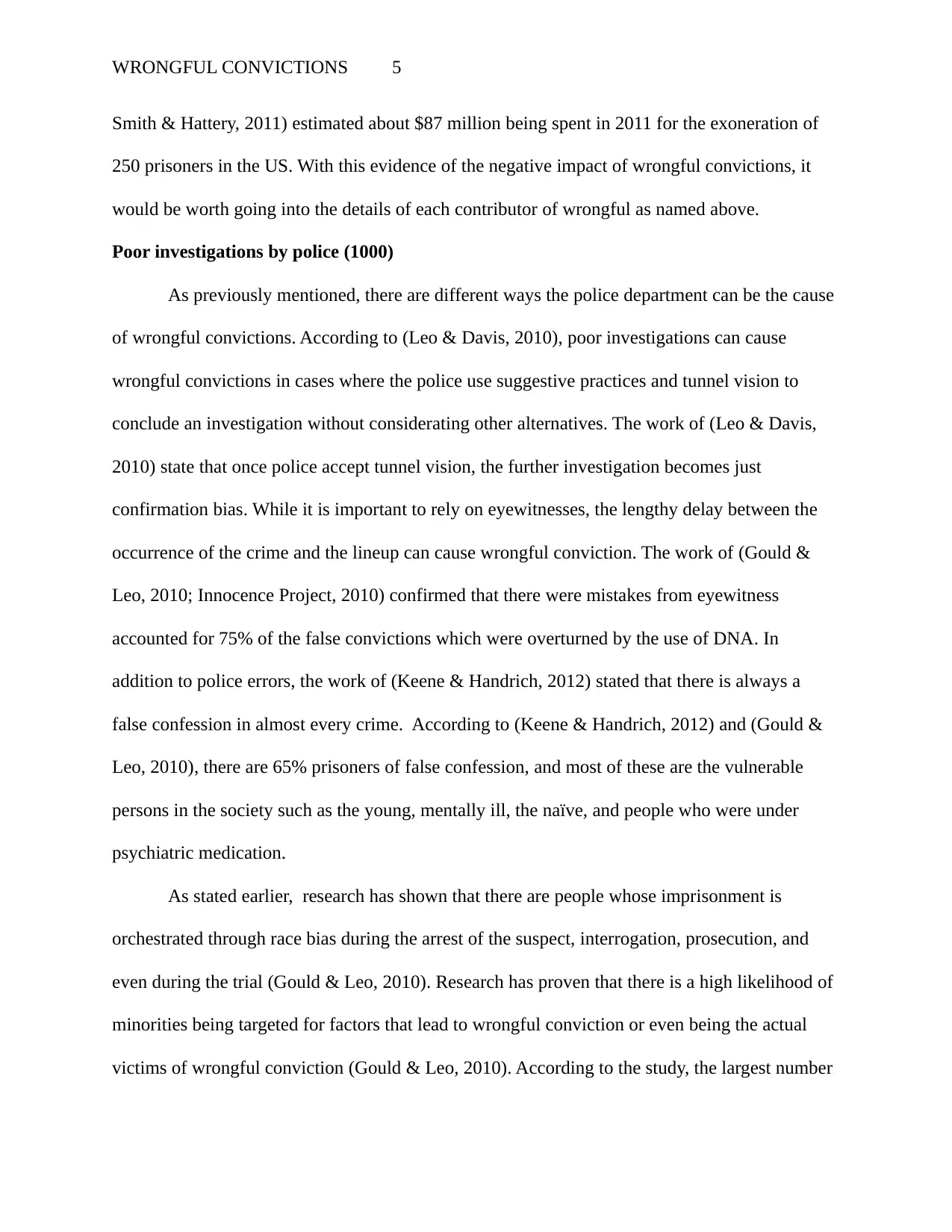
WRONGFUL CONVICTIONS 5
Smith & Hattery, 2011) estimated about $87 million being spent in 2011 for the exoneration of
250 prisoners in the US. With this evidence of the negative impact of wrongful convictions, it
would be worth going into the details of each contributor of wrongful as named above.
Poor investigations by police (1000)
As previously mentioned, there are different ways the police department can be the cause
of wrongful convictions. According to (Leo & Davis, 2010), poor investigations can cause
wrongful convictions in cases where the police use suggestive practices and tunnel vision to
conclude an investigation without considerating other alternatives. The work of (Leo & Davis,
2010) state that once police accept tunnel vision, the further investigation becomes just
confirmation bias. While it is important to rely on eyewitnesses, the lengthy delay between the
occurrence of the crime and the lineup can cause wrongful conviction. The work of (Gould &
Leo, 2010; Innocence Project, 2010) confirmed that there were mistakes from eyewitness
accounted for 75% of the false convictions which were overturned by the use of DNA. In
addition to police errors, the work of (Keene & Handrich, 2012) stated that there is always a
false confession in almost every crime. According to (Keene & Handrich, 2012) and (Gould &
Leo, 2010), there are 65% prisoners of false confession, and most of these are the vulnerable
persons in the society such as the young, mentally ill, the naïve, and people who were under
psychiatric medication.
As stated earlier, research has shown that there are people whose imprisonment is
orchestrated through race bias during the arrest of the suspect, interrogation, prosecution, and
even during the trial (Gould & Leo, 2010). Research has proven that there is a high likelihood of
minorities being targeted for factors that lead to wrongful conviction or even being the actual
victims of wrongful conviction (Gould & Leo, 2010). According to the study, the largest number
Smith & Hattery, 2011) estimated about $87 million being spent in 2011 for the exoneration of
250 prisoners in the US. With this evidence of the negative impact of wrongful convictions, it
would be worth going into the details of each contributor of wrongful as named above.
Poor investigations by police (1000)
As previously mentioned, there are different ways the police department can be the cause
of wrongful convictions. According to (Leo & Davis, 2010), poor investigations can cause
wrongful convictions in cases where the police use suggestive practices and tunnel vision to
conclude an investigation without considerating other alternatives. The work of (Leo & Davis,
2010) state that once police accept tunnel vision, the further investigation becomes just
confirmation bias. While it is important to rely on eyewitnesses, the lengthy delay between the
occurrence of the crime and the lineup can cause wrongful conviction. The work of (Gould &
Leo, 2010; Innocence Project, 2010) confirmed that there were mistakes from eyewitness
accounted for 75% of the false convictions which were overturned by the use of DNA. In
addition to police errors, the work of (Keene & Handrich, 2012) stated that there is always a
false confession in almost every crime. According to (Keene & Handrich, 2012) and (Gould &
Leo, 2010), there are 65% prisoners of false confession, and most of these are the vulnerable
persons in the society such as the young, mentally ill, the naïve, and people who were under
psychiatric medication.
As stated earlier, research has shown that there are people whose imprisonment is
orchestrated through race bias during the arrest of the suspect, interrogation, prosecution, and
even during the trial (Gould & Leo, 2010). Research has proven that there is a high likelihood of
minorities being targeted for factors that lead to wrongful conviction or even being the actual
victims of wrongful conviction (Gould & Leo, 2010). According to the study, the largest number
⊘ This is a preview!⊘
Do you want full access?
Subscribe today to unlock all pages.

Trusted by 1+ million students worldwide
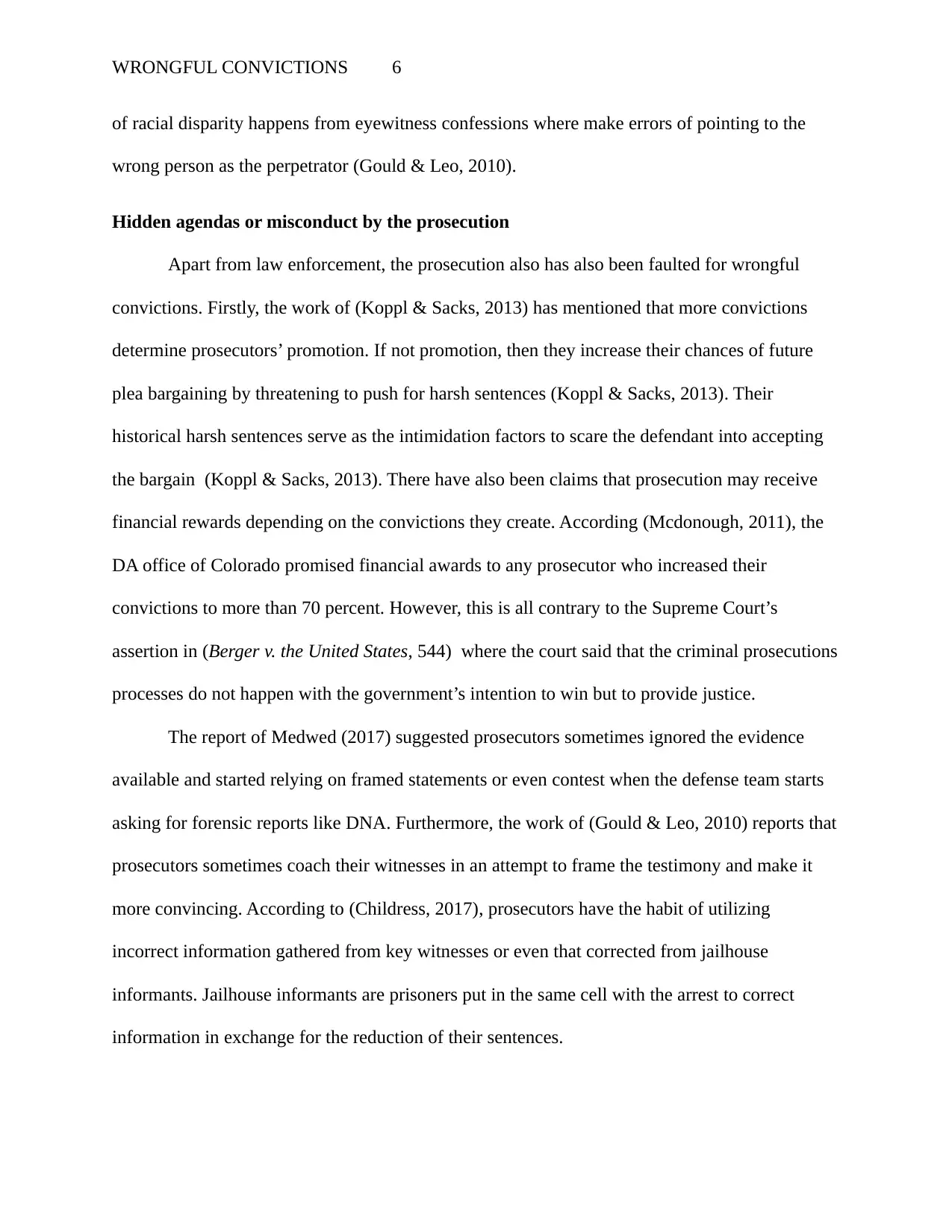
WRONGFUL CONVICTIONS 6
of racial disparity happens from eyewitness confessions where make errors of pointing to the
wrong person as the perpetrator (Gould & Leo, 2010).
Hidden agendas or misconduct by the prosecution
Apart from law enforcement, the prosecution also has also been faulted for wrongful
convictions. Firstly, the work of (Koppl & Sacks, 2013) has mentioned that more convictions
determine prosecutors’ promotion. If not promotion, then they increase their chances of future
plea bargaining by threatening to push for harsh sentences (Koppl & Sacks, 2013). Their
historical harsh sentences serve as the intimidation factors to scare the defendant into accepting
the bargain (Koppl & Sacks, 2013). There have also been claims that prosecution may receive
financial rewards depending on the convictions they create. According (Mcdonough, 2011), the
DA office of Colorado promised financial awards to any prosecutor who increased their
convictions to more than 70 percent. However, this is all contrary to the Supreme Court’s
assertion in (Berger v. the United States, 544) where the court said that the criminal prosecutions
processes do not happen with the government’s intention to win but to provide justice.
The report of Medwed (2017) suggested prosecutors sometimes ignored the evidence
available and started relying on framed statements or even contest when the defense team starts
asking for forensic reports like DNA. Furthermore, the work of (Gould & Leo, 2010) reports that
prosecutors sometimes coach their witnesses in an attempt to frame the testimony and make it
more convincing. According to (Childress, 2017), prosecutors have the habit of utilizing
incorrect information gathered from key witnesses or even that corrected from jailhouse
informants. Jailhouse informants are prisoners put in the same cell with the arrest to correct
information in exchange for the reduction of their sentences.
of racial disparity happens from eyewitness confessions where make errors of pointing to the
wrong person as the perpetrator (Gould & Leo, 2010).
Hidden agendas or misconduct by the prosecution
Apart from law enforcement, the prosecution also has also been faulted for wrongful
convictions. Firstly, the work of (Koppl & Sacks, 2013) has mentioned that more convictions
determine prosecutors’ promotion. If not promotion, then they increase their chances of future
plea bargaining by threatening to push for harsh sentences (Koppl & Sacks, 2013). Their
historical harsh sentences serve as the intimidation factors to scare the defendant into accepting
the bargain (Koppl & Sacks, 2013). There have also been claims that prosecution may receive
financial rewards depending on the convictions they create. According (Mcdonough, 2011), the
DA office of Colorado promised financial awards to any prosecutor who increased their
convictions to more than 70 percent. However, this is all contrary to the Supreme Court’s
assertion in (Berger v. the United States, 544) where the court said that the criminal prosecutions
processes do not happen with the government’s intention to win but to provide justice.
The report of Medwed (2017) suggested prosecutors sometimes ignored the evidence
available and started relying on framed statements or even contest when the defense team starts
asking for forensic reports like DNA. Furthermore, the work of (Gould & Leo, 2010) reports that
prosecutors sometimes coach their witnesses in an attempt to frame the testimony and make it
more convincing. According to (Childress, 2017), prosecutors have the habit of utilizing
incorrect information gathered from key witnesses or even that corrected from jailhouse
informants. Jailhouse informants are prisoners put in the same cell with the arrest to correct
information in exchange for the reduction of their sentences.
Paraphrase This Document
Need a fresh take? Get an instant paraphrase of this document with our AI Paraphraser
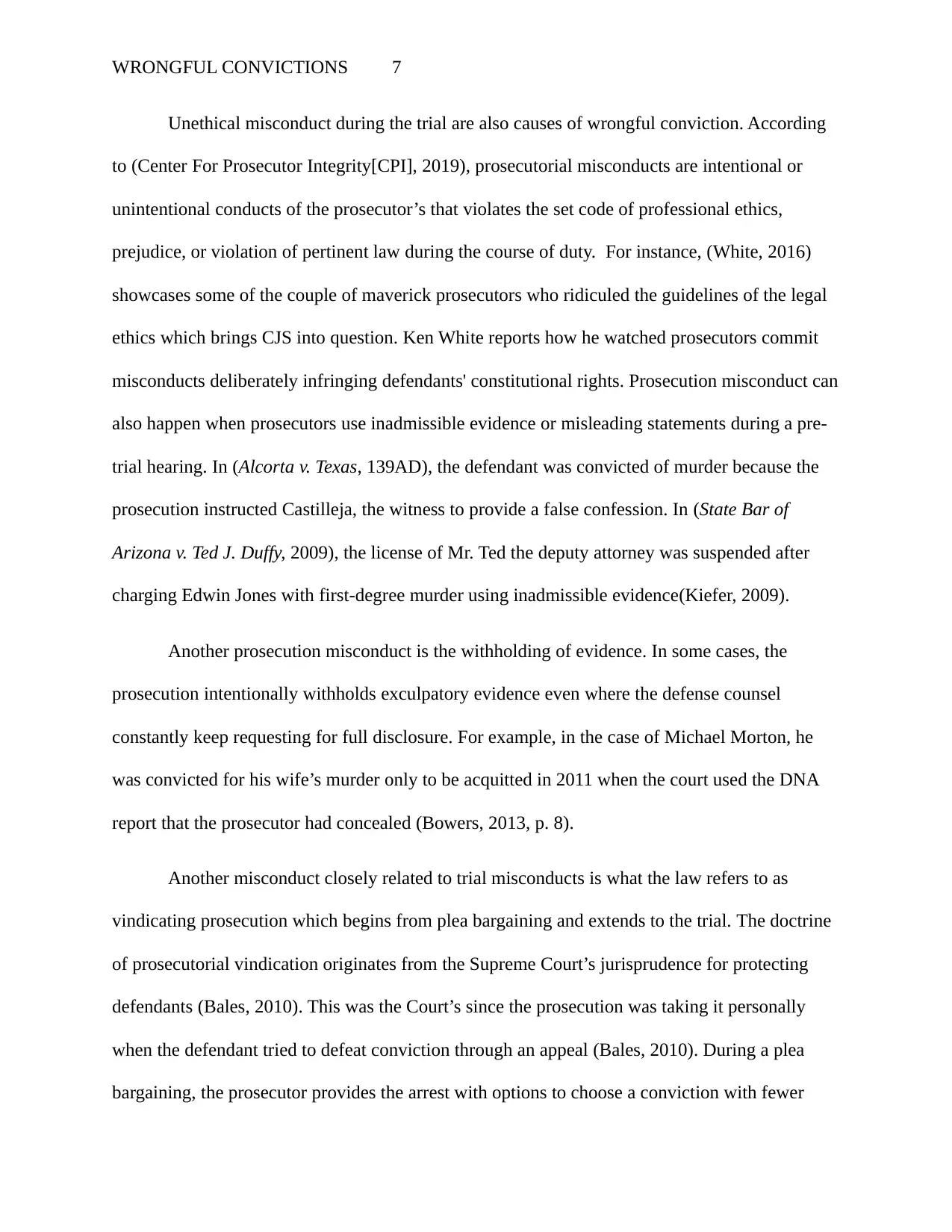
WRONGFUL CONVICTIONS 7
Unethical misconduct during the trial are also causes of wrongful conviction. According
to (Center For Prosecutor Integrity[CPI], 2019), prosecutorial misconducts are intentional or
unintentional conducts of the prosecutor’s that violates the set code of professional ethics,
prejudice, or violation of pertinent law during the course of duty. For instance, (White, 2016)
showcases some of the couple of maverick prosecutors who ridiculed the guidelines of the legal
ethics which brings CJS into question. Ken White reports how he watched prosecutors commit
misconducts deliberately infringing defendants' constitutional rights. Prosecution misconduct can
also happen when prosecutors use inadmissible evidence or misleading statements during a pre-
trial hearing. In (Alcorta v. Texas, 139AD), the defendant was convicted of murder because the
prosecution instructed Castilleja, the witness to provide a false confession. In (State Bar of
Arizona v. Ted J. Duffy, 2009), the license of Mr. Ted the deputy attorney was suspended after
charging Edwin Jones with first-degree murder using inadmissible evidence(Kiefer, 2009).
Another prosecution misconduct is the withholding of evidence. In some cases, the
prosecution intentionally withholds exculpatory evidence even where the defense counsel
constantly keep requesting for full disclosure. For example, in the case of Michael Morton, he
was convicted for his wife’s murder only to be acquitted in 2011 when the court used the DNA
report that the prosecutor had concealed (Bowers, 2013, p. 8).
Another misconduct closely related to trial misconducts is what the law refers to as
vindicating prosecution which begins from plea bargaining and extends to the trial. The doctrine
of prosecutorial vindication originates from the Supreme Court’s jurisprudence for protecting
defendants (Bales, 2010). This was the Court’s since the prosecution was taking it personally
when the defendant tried to defeat conviction through an appeal (Bales, 2010). During a plea
bargaining, the prosecutor provides the arrest with options to choose a conviction with fewer
Unethical misconduct during the trial are also causes of wrongful conviction. According
to (Center For Prosecutor Integrity[CPI], 2019), prosecutorial misconducts are intentional or
unintentional conducts of the prosecutor’s that violates the set code of professional ethics,
prejudice, or violation of pertinent law during the course of duty. For instance, (White, 2016)
showcases some of the couple of maverick prosecutors who ridiculed the guidelines of the legal
ethics which brings CJS into question. Ken White reports how he watched prosecutors commit
misconducts deliberately infringing defendants' constitutional rights. Prosecution misconduct can
also happen when prosecutors use inadmissible evidence or misleading statements during a pre-
trial hearing. In (Alcorta v. Texas, 139AD), the defendant was convicted of murder because the
prosecution instructed Castilleja, the witness to provide a false confession. In (State Bar of
Arizona v. Ted J. Duffy, 2009), the license of Mr. Ted the deputy attorney was suspended after
charging Edwin Jones with first-degree murder using inadmissible evidence(Kiefer, 2009).
Another prosecution misconduct is the withholding of evidence. In some cases, the
prosecution intentionally withholds exculpatory evidence even where the defense counsel
constantly keep requesting for full disclosure. For example, in the case of Michael Morton, he
was convicted for his wife’s murder only to be acquitted in 2011 when the court used the DNA
report that the prosecutor had concealed (Bowers, 2013, p. 8).
Another misconduct closely related to trial misconducts is what the law refers to as
vindicating prosecution which begins from plea bargaining and extends to the trial. The doctrine
of prosecutorial vindication originates from the Supreme Court’s jurisprudence for protecting
defendants (Bales, 2010). This was the Court’s since the prosecution was taking it personally
when the defendant tried to defeat conviction through an appeal (Bales, 2010). During a plea
bargaining, the prosecutor provides the arrest with options to choose a conviction with fewer
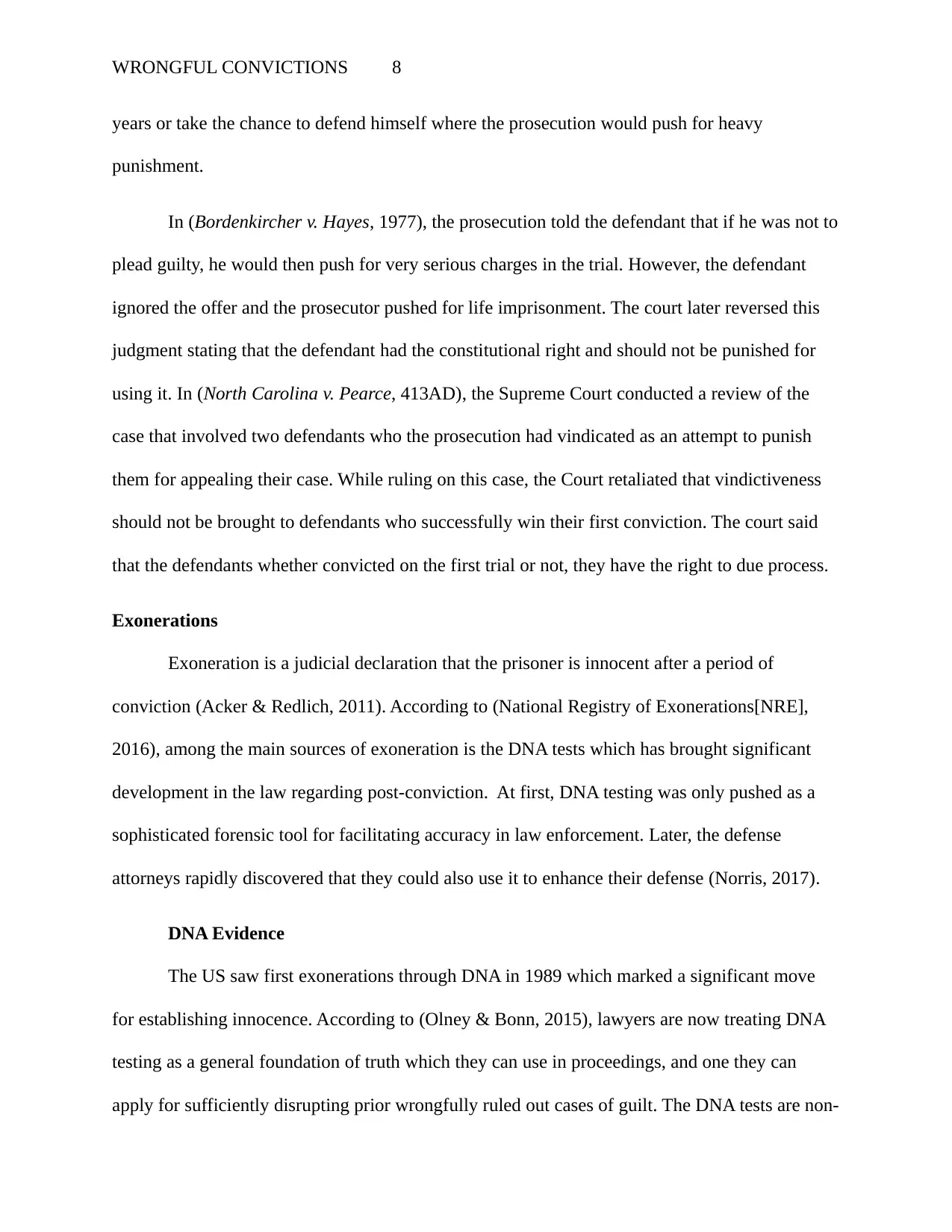
WRONGFUL CONVICTIONS 8
years or take the chance to defend himself where the prosecution would push for heavy
punishment.
In (Bordenkircher v. Hayes, 1977), the prosecution told the defendant that if he was not to
plead guilty, he would then push for very serious charges in the trial. However, the defendant
ignored the offer and the prosecutor pushed for life imprisonment. The court later reversed this
judgment stating that the defendant had the constitutional right and should not be punished for
using it. In (North Carolina v. Pearce, 413AD), the Supreme Court conducted a review of the
case that involved two defendants who the prosecution had vindicated as an attempt to punish
them for appealing their case. While ruling on this case, the Court retaliated that vindictiveness
should not be brought to defendants who successfully win their first conviction. The court said
that the defendants whether convicted on the first trial or not, they have the right to due process.
Exonerations
Exoneration is a judicial declaration that the prisoner is innocent after a period of
conviction (Acker & Redlich, 2011). According to (National Registry of Exonerations[NRE],
2016), among the main sources of exoneration is the DNA tests which has brought significant
development in the law regarding post-conviction. At first, DNA testing was only pushed as a
sophisticated forensic tool for facilitating accuracy in law enforcement. Later, the defense
attorneys rapidly discovered that they could also use it to enhance their defense (Norris, 2017).
DNA Evidence
The US saw first exonerations through DNA in 1989 which marked a significant move
for establishing innocence. According to (Olney & Bonn, 2015), lawyers are now treating DNA
testing as a general foundation of truth which they can use in proceedings, and one they can
apply for sufficiently disrupting prior wrongfully ruled out cases of guilt. The DNA tests are non-
years or take the chance to defend himself where the prosecution would push for heavy
punishment.
In (Bordenkircher v. Hayes, 1977), the prosecution told the defendant that if he was not to
plead guilty, he would then push for very serious charges in the trial. However, the defendant
ignored the offer and the prosecutor pushed for life imprisonment. The court later reversed this
judgment stating that the defendant had the constitutional right and should not be punished for
using it. In (North Carolina v. Pearce, 413AD), the Supreme Court conducted a review of the
case that involved two defendants who the prosecution had vindicated as an attempt to punish
them for appealing their case. While ruling on this case, the Court retaliated that vindictiveness
should not be brought to defendants who successfully win their first conviction. The court said
that the defendants whether convicted on the first trial or not, they have the right to due process.
Exonerations
Exoneration is a judicial declaration that the prisoner is innocent after a period of
conviction (Acker & Redlich, 2011). According to (National Registry of Exonerations[NRE],
2016), among the main sources of exoneration is the DNA tests which has brought significant
development in the law regarding post-conviction. At first, DNA testing was only pushed as a
sophisticated forensic tool for facilitating accuracy in law enforcement. Later, the defense
attorneys rapidly discovered that they could also use it to enhance their defense (Norris, 2017).
DNA Evidence
The US saw first exonerations through DNA in 1989 which marked a significant move
for establishing innocence. According to (Olney & Bonn, 2015), lawyers are now treating DNA
testing as a general foundation of truth which they can use in proceedings, and one they can
apply for sufficiently disrupting prior wrongfully ruled out cases of guilt. The DNA tests are non-
⊘ This is a preview!⊘
Do you want full access?
Subscribe today to unlock all pages.

Trusted by 1+ million students worldwide
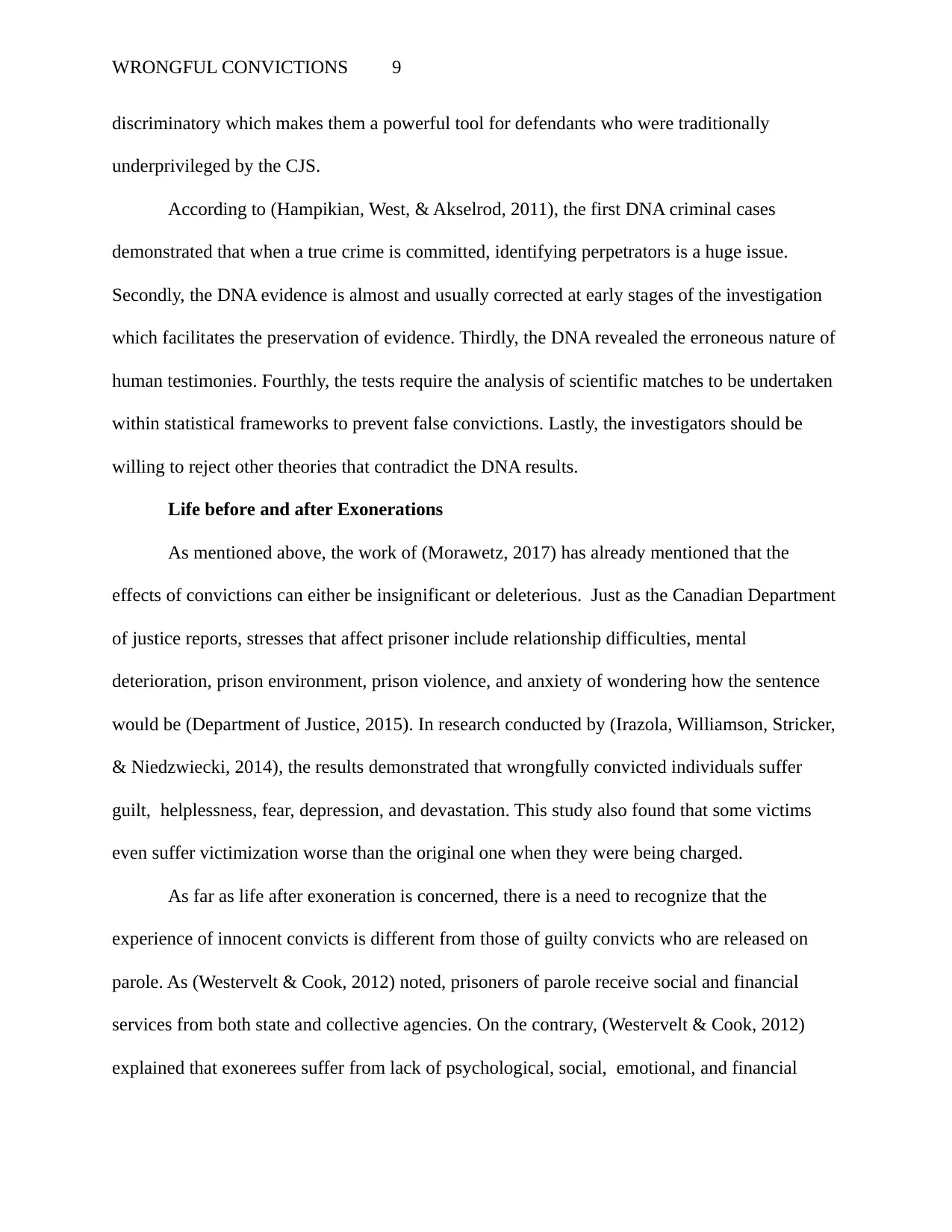
WRONGFUL CONVICTIONS 9
discriminatory which makes them a powerful tool for defendants who were traditionally
underprivileged by the CJS.
According to (Hampikian, West, & Akselrod, 2011), the first DNA criminal cases
demonstrated that when a true crime is committed, identifying perpetrators is a huge issue.
Secondly, the DNA evidence is almost and usually corrected at early stages of the investigation
which facilitates the preservation of evidence. Thirdly, the DNA revealed the erroneous nature of
human testimonies. Fourthly, the tests require the analysis of scientific matches to be undertaken
within statistical frameworks to prevent false convictions. Lastly, the investigators should be
willing to reject other theories that contradict the DNA results.
Life before and after Exonerations
As mentioned above, the work of (Morawetz, 2017) has already mentioned that the
effects of convictions can either be insignificant or deleterious. Just as the Canadian Department
of justice reports, stresses that affect prisoner include relationship difficulties, mental
deterioration, prison environment, prison violence, and anxiety of wondering how the sentence
would be (Department of Justice, 2015). In research conducted by (Irazola, Williamson, Stricker,
& Niedzwiecki, 2014), the results demonstrated that wrongfully convicted individuals suffer
guilt, helplessness, fear, depression, and devastation. This study also found that some victims
even suffer victimization worse than the original one when they were being charged.
As far as life after exoneration is concerned, there is a need to recognize that the
experience of innocent convicts is different from those of guilty convicts who are released on
parole. As (Westervelt & Cook, 2012) noted, prisoners of parole receive social and financial
services from both state and collective agencies. On the contrary, (Westervelt & Cook, 2012)
explained that exonerees suffer from lack of psychological, social, emotional, and financial
discriminatory which makes them a powerful tool for defendants who were traditionally
underprivileged by the CJS.
According to (Hampikian, West, & Akselrod, 2011), the first DNA criminal cases
demonstrated that when a true crime is committed, identifying perpetrators is a huge issue.
Secondly, the DNA evidence is almost and usually corrected at early stages of the investigation
which facilitates the preservation of evidence. Thirdly, the DNA revealed the erroneous nature of
human testimonies. Fourthly, the tests require the analysis of scientific matches to be undertaken
within statistical frameworks to prevent false convictions. Lastly, the investigators should be
willing to reject other theories that contradict the DNA results.
Life before and after Exonerations
As mentioned above, the work of (Morawetz, 2017) has already mentioned that the
effects of convictions can either be insignificant or deleterious. Just as the Canadian Department
of justice reports, stresses that affect prisoner include relationship difficulties, mental
deterioration, prison environment, prison violence, and anxiety of wondering how the sentence
would be (Department of Justice, 2015). In research conducted by (Irazola, Williamson, Stricker,
& Niedzwiecki, 2014), the results demonstrated that wrongfully convicted individuals suffer
guilt, helplessness, fear, depression, and devastation. This study also found that some victims
even suffer victimization worse than the original one when they were being charged.
As far as life after exoneration is concerned, there is a need to recognize that the
experience of innocent convicts is different from those of guilty convicts who are released on
parole. As (Westervelt & Cook, 2012) noted, prisoners of parole receive social and financial
services from both state and collective agencies. On the contrary, (Westervelt & Cook, 2012)
explained that exonerees suffer from lack of psychological, social, emotional, and financial
Paraphrase This Document
Need a fresh take? Get an instant paraphrase of this document with our AI Paraphraser
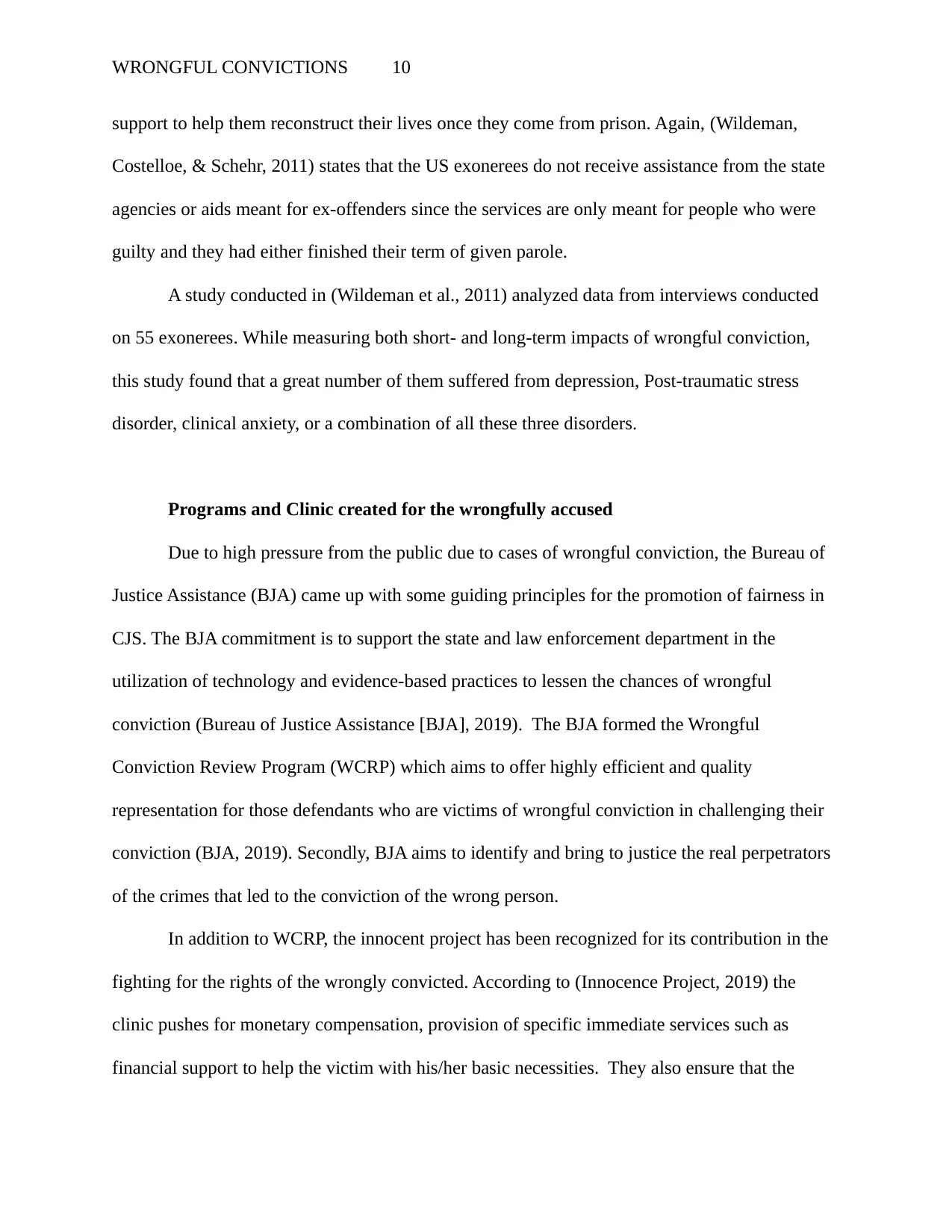
WRONGFUL CONVICTIONS 10
support to help them reconstruct their lives once they come from prison. Again, (Wildeman,
Costelloe, & Schehr, 2011) states that the US exonerees do not receive assistance from the state
agencies or aids meant for ex-offenders since the services are only meant for people who were
guilty and they had either finished their term of given parole.
A study conducted in (Wildeman et al., 2011) analyzed data from interviews conducted
on 55 exonerees. While measuring both short- and long-term impacts of wrongful conviction,
this study found that a great number of them suffered from depression, Post-traumatic stress
disorder, clinical anxiety, or a combination of all these three disorders.
Programs and Clinic created for the wrongfully accused
Due to high pressure from the public due to cases of wrongful conviction, the Bureau of
Justice Assistance (BJA) came up with some guiding principles for the promotion of fairness in
CJS. The BJA commitment is to support the state and law enforcement department in the
utilization of technology and evidence-based practices to lessen the chances of wrongful
conviction (Bureau of Justice Assistance [BJA], 2019). The BJA formed the Wrongful
Conviction Review Program (WCRP) which aims to offer highly efficient and quality
representation for those defendants who are victims of wrongful conviction in challenging their
conviction (BJA, 2019). Secondly, BJA aims to identify and bring to justice the real perpetrators
of the crimes that led to the conviction of the wrong person.
In addition to WCRP, the innocent project has been recognized for its contribution in the
fighting for the rights of the wrongly convicted. According to (Innocence Project, 2019) the
clinic pushes for monetary compensation, provision of specific immediate services such as
financial support to help the victim with his/her basic necessities. They also ensure that the
support to help them reconstruct their lives once they come from prison. Again, (Wildeman,
Costelloe, & Schehr, 2011) states that the US exonerees do not receive assistance from the state
agencies or aids meant for ex-offenders since the services are only meant for people who were
guilty and they had either finished their term of given parole.
A study conducted in (Wildeman et al., 2011) analyzed data from interviews conducted
on 55 exonerees. While measuring both short- and long-term impacts of wrongful conviction,
this study found that a great number of them suffered from depression, Post-traumatic stress
disorder, clinical anxiety, or a combination of all these three disorders.
Programs and Clinic created for the wrongfully accused
Due to high pressure from the public due to cases of wrongful conviction, the Bureau of
Justice Assistance (BJA) came up with some guiding principles for the promotion of fairness in
CJS. The BJA commitment is to support the state and law enforcement department in the
utilization of technology and evidence-based practices to lessen the chances of wrongful
conviction (Bureau of Justice Assistance [BJA], 2019). The BJA formed the Wrongful
Conviction Review Program (WCRP) which aims to offer highly efficient and quality
representation for those defendants who are victims of wrongful conviction in challenging their
conviction (BJA, 2019). Secondly, BJA aims to identify and bring to justice the real perpetrators
of the crimes that led to the conviction of the wrong person.
In addition to WCRP, the innocent project has been recognized for its contribution in the
fighting for the rights of the wrongly convicted. According to (Innocence Project, 2019) the
clinic pushes for monetary compensation, provision of specific immediate services such as
financial support to help the victim with his/her basic necessities. They also ensure that the
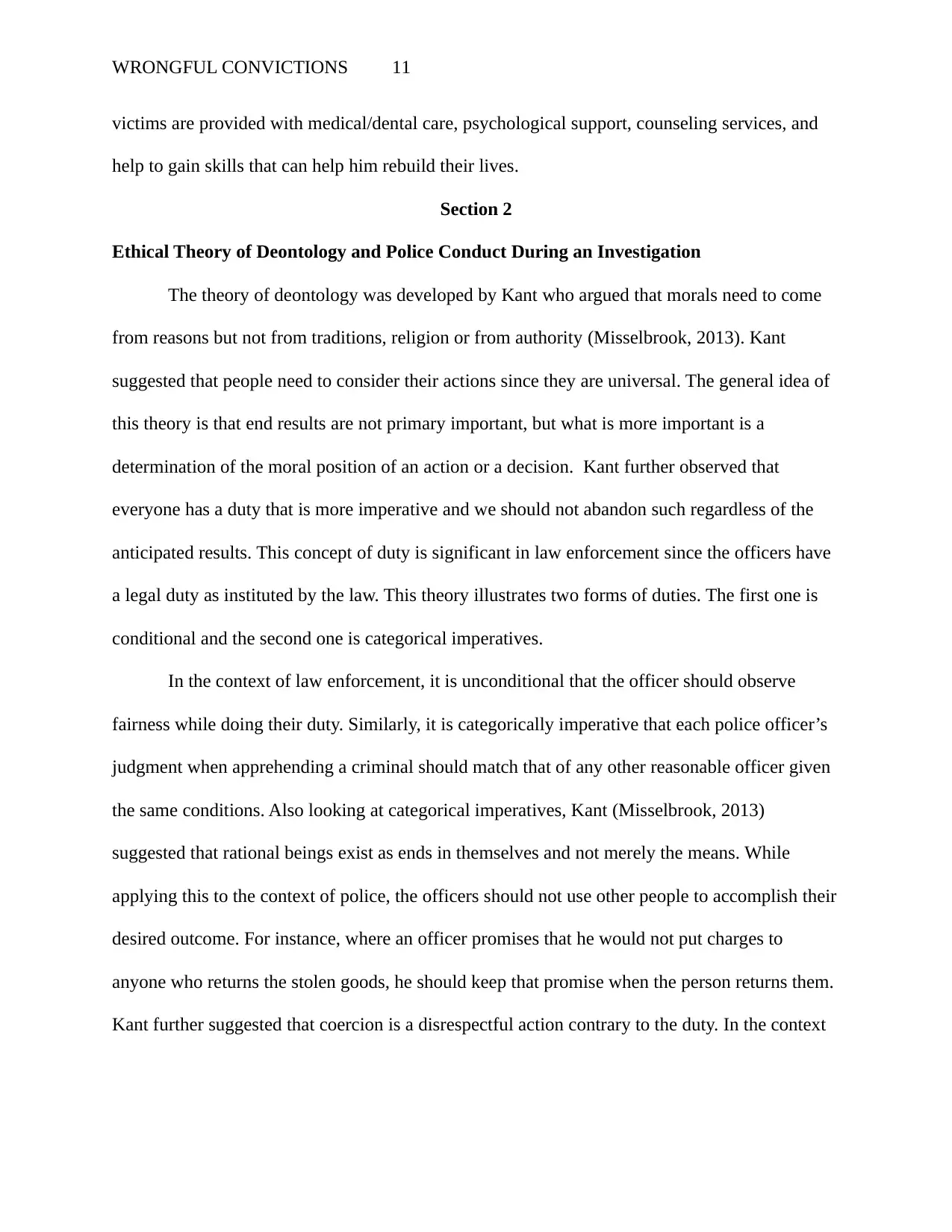
WRONGFUL CONVICTIONS 11
victims are provided with medical/dental care, psychological support, counseling services, and
help to gain skills that can help him rebuild their lives.
Section 2
Ethical Theory of Deontology and Police Conduct During an Investigation
The theory of deontology was developed by Kant who argued that morals need to come
from reasons but not from traditions, religion or from authority (Misselbrook, 2013). Kant
suggested that people need to consider their actions since they are universal. The general idea of
this theory is that end results are not primary important, but what is more important is a
determination of the moral position of an action or a decision. Kant further observed that
everyone has a duty that is more imperative and we should not abandon such regardless of the
anticipated results. This concept of duty is significant in law enforcement since the officers have
a legal duty as instituted by the law. This theory illustrates two forms of duties. The first one is
conditional and the second one is categorical imperatives.
In the context of law enforcement, it is unconditional that the officer should observe
fairness while doing their duty. Similarly, it is categorically imperative that each police officer’s
judgment when apprehending a criminal should match that of any other reasonable officer given
the same conditions. Also looking at categorical imperatives, Kant (Misselbrook, 2013)
suggested that rational beings exist as ends in themselves and not merely the means. While
applying this to the context of police, the officers should not use other people to accomplish their
desired outcome. For instance, where an officer promises that he would not put charges to
anyone who returns the stolen goods, he should keep that promise when the person returns them.
Kant further suggested that coercion is a disrespectful action contrary to the duty. In the context
victims are provided with medical/dental care, psychological support, counseling services, and
help to gain skills that can help him rebuild their lives.
Section 2
Ethical Theory of Deontology and Police Conduct During an Investigation
The theory of deontology was developed by Kant who argued that morals need to come
from reasons but not from traditions, religion or from authority (Misselbrook, 2013). Kant
suggested that people need to consider their actions since they are universal. The general idea of
this theory is that end results are not primary important, but what is more important is a
determination of the moral position of an action or a decision. Kant further observed that
everyone has a duty that is more imperative and we should not abandon such regardless of the
anticipated results. This concept of duty is significant in law enforcement since the officers have
a legal duty as instituted by the law. This theory illustrates two forms of duties. The first one is
conditional and the second one is categorical imperatives.
In the context of law enforcement, it is unconditional that the officer should observe
fairness while doing their duty. Similarly, it is categorically imperative that each police officer’s
judgment when apprehending a criminal should match that of any other reasonable officer given
the same conditions. Also looking at categorical imperatives, Kant (Misselbrook, 2013)
suggested that rational beings exist as ends in themselves and not merely the means. While
applying this to the context of police, the officers should not use other people to accomplish their
desired outcome. For instance, where an officer promises that he would not put charges to
anyone who returns the stolen goods, he should keep that promise when the person returns them.
Kant further suggested that coercion is a disrespectful action contrary to the duty. In the context
⊘ This is a preview!⊘
Do you want full access?
Subscribe today to unlock all pages.

Trusted by 1+ million students worldwide
1 out of 21
Your All-in-One AI-Powered Toolkit for Academic Success.
+13062052269
info@desklib.com
Available 24*7 on WhatsApp / Email
![[object Object]](/_next/static/media/star-bottom.7253800d.svg)
Unlock your academic potential
Copyright © 2020–2025 A2Z Services. All Rights Reserved. Developed and managed by ZUCOL.